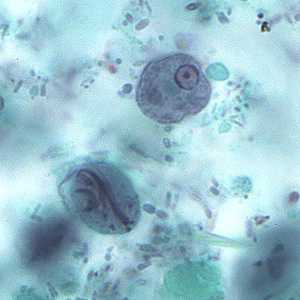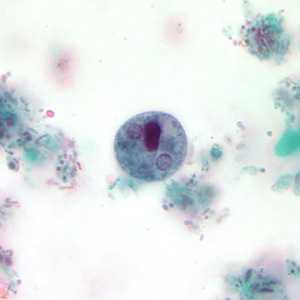
Case #207 - July, 2007
Images captured from a trichrome stained smear were submitted to DPDx for diagnostic assistance. The smears were made from a polyvinyl-alcohol (PVA) preserved fecal specimen, but no other patient or specimen information was given. The submitter wanted confirmation for one parasite they had identified and was not sure of the other organism observed on the smear. Figures A-C show the objects in question under 1000× magnification. All images were cropped to the same dimensions by DPDx. What is your diagnosis? Based on what criteria? What valuable information would have been useful if provided?

Figure A

Figure B

Figure C
Case Answer
This was a case of giardiasis caused by Giardia duodenalis. Also shown were cysts and trophozoites of Entamoeba hartmanni, a nonpathogenic amoeba. Diagnostic features were:
- the shape of the Giardia cyst (blue arrow, Figure A), and the presence of fibrils (green arrow, Figure A) and intracystic bodies (red arrow). Three nuclei were faintly visible as well. Follow-up email communication with the submitter confirmed the size to be about 10 micrometers in length.
- cysts of E, hartmanni that had four or less nuclei and rounded chromatoid bodies. These features are consistent with E. histolytica, E. dispar, and E. hartmanni but size helps distinguish E. histolytica/E. dispar from E. hartmanni.
- a trophozoite of E. hartmanni that had a small, discrete, centrally located karysome, finely granular cytoplasm, and somewhat even peripheral nuclear chromatin. These features are also consistent with the three ameba listed above but, again, size is a distinguishing feature.

Figure A
In this case, size was not given, but the size of the E. hartmanni could be extrapolated based on the size of the neighboring G. duodenalis cyst.
More on: Giardiasis: Nonpathogenic amoebae
Images presented in the monthly case studies are from specimens submitted for diagnosis or archiving. On rare occasions, clinical histories given may be partly fictitious.
DPDx is an education resource designed for health professionals and laboratory scientists. For an overview including prevention and control visit www.cdc.gov/parasites/.
- Page last reviewed: August 24, 2016
- Page last updated: August 24, 2016
- Content source:
- Global Health – Division of Parasitic Diseases and Malaria
- Notice: Linking to a non-federal site does not constitute an endorsement by HHS, CDC or any of its employees of the sponsors or the information and products presented on the site.
- Maintained By:


 ShareCompartir
ShareCompartir